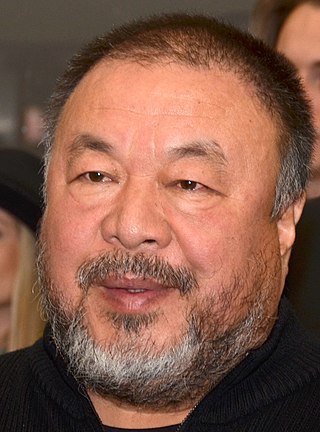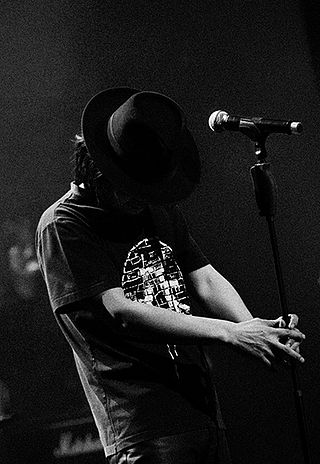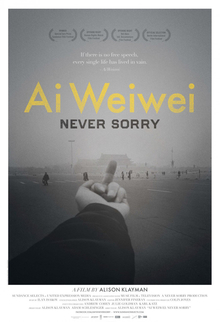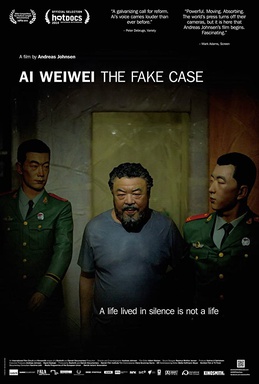Related Research Articles
Feng Boyi is an independent art curator and critic in China. His work focusses primarily on contemporary Chinese art, working with museums and displaying art collections. He has worked several times with artist Ai Weiwei, publishing his journals illegally or working with him in exhibitions and has organized many controversial art exhibitions in China. He has been assistant editor of the China Artists' Association newsletter Artist's Communication since 1988. He has also edited and published numerous catalogues and papers on art and established the Artists' Alliance, a major online forum for contemporary art in China. Feng Boyi has been known to be an instigator to the up-and-coming contemporary art movement in Beijing, starting with publishing articles and journals from artists Ai Weiwei and Xu Bing.

Ai Weiwei is a Chinese contemporary artist, documentarian, and activist. Ai grew up in the far northwest of China, where he lived under harsh conditions due to his father's exile. As an activist, he has been openly critical of the Chinese Government's stance on democracy and human rights. He investigated government corruption and cover-ups, in particular the Sichuan schools corruption scandal following the collapse of "tofu-dreg schools" in the 2008 Sichuan earthquake. In April 2011, Ai Weiwei was arrested at Beijing Capital International Airport for "economic crimes," and detained for 81 days without charge. Ai Weiwei emerged as a vital instigator in Chinese cultural development, an architect of Chinese modernism, and one of the nation's most vocal political commentators.
Excessivism is an art movement. In 2015 American artist and curator Kaloust Guedel introduced it to the world with an exhibition titled Excessivist Initiative. The review of the exhibition written by art critic and curator Shana Nys Dambrot, titled "Excessivism: Irony, Imbalance and a New Rococo" was published in the Huffington Post. Its early adopters go back to late 20th century.

Zuoxiao Zuzhou, is a Chinese musician and artist.

ArtReview is an international contemporary art magazine based in London, founded in 1948. Its sister publication, ArtReview Asia, was established in 2013.
The year 2011 in art involved some significant events and new works.

Kevin Abosch is an Irish conceptual artist and pioneer in cryptoart known for his works in photography, blockchain, sculpture, installation, AI and film. Abosch's work addresses the nature of identity, value and human currency and has been exhibited throughout the world, often in civic spaces, including The Hermitage Museum, The National Gallery of Ireland, The National Museum of China, The Irish Museum of Modern Art, The Museum of Contemporary Art Vojvodina, The Bogotá Museum of Modern Art, ZKM, Galerie nationale du Jeu de Paume, and Dublin Airport.
The 2011 crackdown on dissidents in China refers to the arrest of dozens of mainland Chinese rights lawyers, activists and grassroots agitators in a response to the 2011 Chinese pro-democracy protests. Since the protests, at least 54 Chinese activists have been arrested or detained by authorities in the biggest crackdown on dissent since the 1989 Tiananmen Square protests and massacre. Since the start of the protests in mid-February 2011, human rights groups have claimed that more than 54 people have been arrested by authorities, some of whom have been charged with crimes. Among those arrested are bloggers who criticise the government such as Ai Weiwei, lawyers who pursue cases against the government, and human rights activists.

The Free Ai Weiwei street art campaign was a series of protests during the PRC government's secret detention of Chinese artist Ai Weiwei for 81 days in 2011, organised by Hong Kong artists and art supporters. Various slogans calling for the immediate release of the artist such as "Free Ai Weiwei", and "Who's afraid of Ai Weiwei" accompany stencilled images of Ai were applied onto pavements, pedestrian overpass, and building walls all over Hong Kong, and similar posters and signs were displayed worldwide.

Ai Weiwei: Never Sorry is a 2012 documentary film about Chinese artist and activist Ai Weiwei, directed by American filmmaker Alison Klayman.

Circle of Animals/Zodiac Heads is an artwork by Chinese contemporary artist and political commentator, Ai Weiwei. The work comes in a small (gold) and large (bronze) version.
WeiweiCam is a self-surveillance project by artist Ai Weiwei, in China, that went live on April 3, 2012, exactly one year after the artist's detention by Chinese officials at Beijing Airport. At least fifteen surveillance cameras monitor his house in Beijing which, according to Ai, makes it the most-watched spot of the city.

Gangnam for Freedom is a 2012 video clip produced by the British sculptor Anish Kapoor. It is a parody of the international K-pop hit single "Gangnam Style", and it was created to advocate the freedom of expression as well as to support the Chinese dissident Ai Weiwei, whose parody of "Gangnam Style" was blocked by Chinese authorities immediately after it was uploaded. The video features appearances by the staff of numerous contemporary art museums as well as human rights activists from Liberty, Index on Censorship, The Helen Bamber Foundation, and Amnesty International.

Ai Weiwei: The Fake Case is a 2013 documentary film about Chinese artist and activist Ai Weiwei, directed by Danish filmmaker Andreas Johnsen. The film won Best 2014 Documentary in Danish Film Critics Association's 67th Bodil Awards, played in the official selection of 2014 Hot Docs Canadian International Documentary Festival in Toronto and International Documentary Film Festival Amsterdam.

Jeff Kelley is an art critic, author, and curator. A practicing art critic since 1977, his reviews and essays about artists including Chinese conceptual artist Ai Weiwei have appeared in publications including Artforum, Art in America, and the Los Angeles Times.

Kui Hua Zi (Sunflower Seeds) is an art installation created by contemporary artist and political activist Ai Weiwei. It was first exhibited at the Tate Modern art gallery in London from 12 October 2010 to 2 May 2011. The work consisted of one hundred million individually hand-crafted porcelain sunflower seeds which filled the gallery's 1,000 square metre Turbine Hall to depth of ten centimetres.

Alison Klayman is an American filmmaker and journalist best known for her award-winning 2012 documentary Ai Weiwei: Never Sorry.
Lu Qing is a Chinese modern and contemporary artist.

Man in a cube is a contemporary sculpture created by Chinese artist Ai Weiwei in 2017 for the exhibition Luther and the Avant-Garde marking the quincentenary of the Reformation. It has been on permanent display in the courtyard of Lutherhaus Eisenach since October 2020.
References
- 1 2 Secher, Benjamin (12 October 2010). "Ai Weiwei's 'Map of China': setting a new benchmark". The Daily Telegraph . Retrieved 2 April 2013.
- 1 2 Garcia, Cathy Rose A. (9 May 2008). "Artist Ai Weiwei Holds First Exhibit". The Korea Times . Retrieved 2 April 2013.
- ↑ Perl, Jed (1 February 2013). "Ai Weiwei: Wonderful dissident, terrible artist". The New Republic . Chris Hughes . Retrieved 2 April 2013.